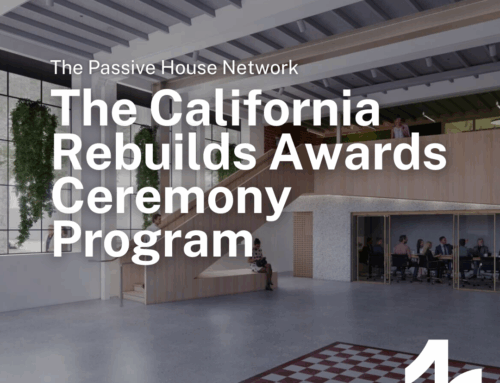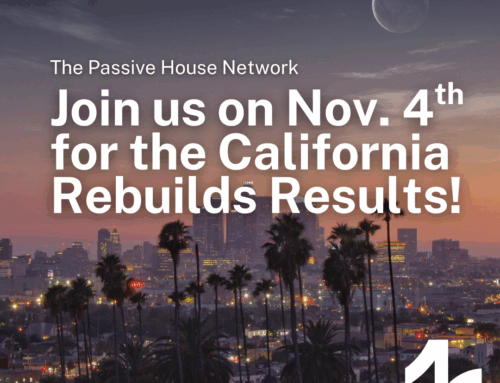On June 3rd, California’s Codes and Standards (CASE) team released a list of measures it will explore for the 2022 code cycle. The list includes a proposal to explore a ‘Passive House Prescriptive Pathway’ in the Single Family category, reflecting a growing influence on energy code development being exerted by the Passive House standard in California. Also listed for review in the commercial and multifamily sections were a host of measures integral to Passive House building design, including the addition of Heat Recovery Ventilation systems, an exploration to reduce infiltration (aka air-sealing) and an ambitious proposal to require thermal bridge calculations.
The above announcements preceded a more recent report issued by CASE for a Passive House Low-Rise Multifamily Reach Code. This addendum to already approved reach code options offers California’s cities a remarkable opportunity to accelerate building efficiency well beyond the fuel-switching codes currently being considered by many. Passive House California (PHCA) – our California affiliate – offered this review of the CASE report, which clearly highlighted a plethora of unexplored opportunities for cost-effective building decarbonization.
Figure 1: PHCA’s Reach Code showing all-electric Passive House low-rise multifamily building improvement compared to the baseline margins required to qualify for a 2019 Reach Code.
Orchestrated Efforts
These announcements form part of a growing number of signals being sent by the California Codes and Standards, indicating that Passive House is on the rise. This, added to regular mentions of Passive House by popular California Energy Commissioner, Andrew McAllister, means local policymakers, professionals and code enforcement agents would do well to educate themselves on the details, tools and protocols utilized by the Passive House standard. The results shown above extracted from PHCA’s Low-Rise Multifamily Reach Code report reveal some of the reasons why California’s energy code developers are clearly eager to support the acceleration of all Passive House building types in California.
Building Code Momentum
Elsewhere across North America, similar measures are being proposed and advanced by many more NAPHN chapters and affiliates. This collective action is having a force-multiplier effect on North America’s building codes. In New York, the members of New York Passive House (NYPH) have been diligently supporting and promoting efforts at state and local levels to incentivize Passive House acceleration. Based on the number of projects identified on this map, their efforts are clearly working!
PHPP Use for Code Compliance
Additionally, NYPH is inches away from having the Passive House Planning Package (PHPP) accepted as an alternate compliance energy model. This comes on the heels of the successful validation of the PHPP via the ASHRAE 140 energy modeling protocol, which was collectively supported by our network members, Passive House Canada, PHCA, NYPH and PHI. We anticipate other regions will soon accept the PHPP as a compliance modeling tool, to follow the lead by Canadian policy-makers in British Columbia, where this is already in place.
Across the river, our New Jersey Passive House members are actively engaged in driving their State Climate Action plan towards higher performance measures. We anticipate some advances there as a result. Other NAPHN chapters in Minnesota and Washington DC are providing similar support to their local policymakers, which we’re actively supporting. Further out west, our Passive House Rocky Mountains chapter is making great inroads in Denver, as well as other parts of this central plains region. We’re actively collaborating with NBI to deliver a reach code proposal to the City of Denver and look forward to sharing details here as they emerge.
Policy Resource Guide
Much of the above policy and code activity has been influenced by the programs and policies we identified in our Policy Resource Guide. This guide is proving to be an invaluable advocacy tool for our extended community, providing excellent resources and ideas to share with their progressive policy maker colleagues. We look forward to expanding this guide in the future, and providing updates on the progress being made to utilize the clear framework and effective protocols embedded in Passive House to build the world we want!
***
Local Professional & Trades Trainings
We recognize that policy makers are only able to implement great policies to meet their required climate action goals when local professionals can reliably deliver performance targets. For this reason, NAPHN has focused our efforts on offering exceptional Passive House trainings and is committed to providing accessible training options across the continent. Courses directed at building professionals and tradespersons are now regularly hosted at a growing number of venues across the country. Locate your nearest training here.
Customized Trainings
NAPHN has developed customized training programs to address specific building types and specialized program needs. We are pleased to be working with a number of cities, counties and school districts to support their local climate action goals and programs. Contact us to enquire about customized trainings or workshops in your region: info@naphnetwork.org.




